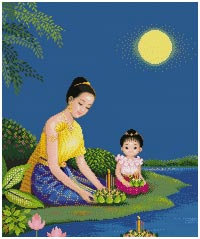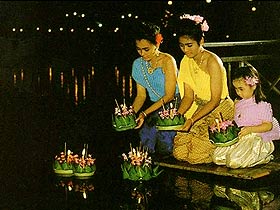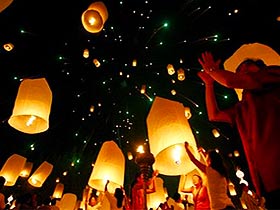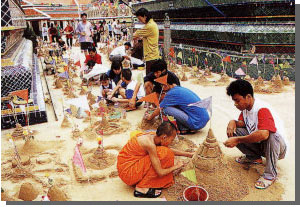Origin
Buddhist Lent Day mars the beginning
of the annual retreat for monks as laid down by Lord Buddha more than
twenty-five centuries ago. On that day all monks take a vow to stay in a
particular place or temple for three months from the first Day of the
Waning moon in the
8th Month to the 15th Day of the Waxing Moon in the 11th Month. It
coincides with the rainy season during which the monks are not allowed
to stay overnight anywhere else, except in exceptional cases based on
reasons granted by Lord Buddha.
Buddhist Lent day means the day on which the
Buddhist monks take the vow to stay only at one particular place or
temple which can shelter them from the sun, storms and rain.
Significance
For Buddhism and its followers, Buddhist Lent has the following important characteristics :
1. Buddhist monks who have been travelling from
place to place have totake up shelter in a particular place, according
to Lord Buddha’s discipline.
2. Buddhist monks who stay at a particular place
for a length of time shall teach young boys who wish to be ordained in
order to study the Buddhist Doctrine and preach to lay followers.
3. During the Buddhist Lent, lay followers refrain
from bad actions, in particular drinking alcohol, taking drugs or
leading an inappropriate life.
4. During the Buddhist Lent, laymen acquire merit,
observe five or eight precepts, listen to sermons and sit in meditation
in temples.
Historical Background
Lord Buddha’s Motives for Laying Down the Discipline of the Buddhist Lent
When Lord Buddha was staying at Veluvana Temple in
Rajagriha City of Magadha State, a group of people complained to Lord
Buddha that the Buddhist monks did not act appropriately, as they kept
travelling even in the rainy season, walking through the rice fields,
and damaging the farmer’s paddies, while ordained people of other
religions stopped travelling and took retreat. Lord Buddha held a
meeting, the Buddhist monks discussed the matter, and in the end Lord
Buddha formulated the rule enforcing all Buddhist monks to take retreat
during the rainy season by uttering the following words :
“Anujanami Bhikkhave Vassang Upagantung.”
O Bhikkhus, I allow you to observe the Lent Retreat.
Buddhist Lent Day usually falls on the 1st Waning
Moon Day of the 8th Month and the retreat ends on the 15th Waxing Moon
day of the 11th Month, which is also known as the First Buddhist Lent
Day (Purima Pansa). In some years, two Eight Lunar Months occur, and in
that case, Buddhist Lent Day is postponed to the 1st Waning Moon of the
2nd Eight Month, or the 1st Waning Moon Day of the Ninth Month (Pajchima
Pansa) until the 15th Waxing Moon Day of the 12th Month, which is the
end of the Second Buddhist Lent (Pajchima Pansa).
Practices for Laymen during the Buddhist Lent Retreat
In the past, the majority of the Thai people were
farmers. They began their work in the fields before the rainy season,
and by the time Buddhist monks took the vow to observe the Lent retreat,
all farmers were free and could go to temples. There were no modern
means of transportation, and the rivers and canals were full of water
which enforced a sedentary life upon the farmers, during which they
observed five or eight precepts, made offering to the monks, listened to
sermons and practised meditation.
In the temples, which were located near the
farmers’ houses, the monks would accept their offerings for their stay
during the Buddhist Lent, and preach the Buddhist Doctrine, strengthen
the faith of the people to acquire merit, observe the precepts and
develop mindfulness by sitting in meditation.
The Thai people have been known to observe
Buddhist lent since the Sukhothai period, of which the stone inscription
made in the reign of King Ramkhamhaeng the Great is historical
evidence. It reads as follows :
“King Ramkhamhaeng of Sukhothai together with
his noblemen and commoners, both men and women from all walks of life,
had great faith in Buddhism and observed the precepts during Buddhist
Lent.”
Besides observing the precepts, Thai Buddhists
acquired merit during the annual retreat by observing local customs
which were recorded in a book ascribed to the well-known Nang Noppamas
as follows:
“In the 8th Month a religious rite was held to
mark Buddhist Lent, during which Buddhist monks stayed at their temples
for the rainy season. At Royal temples, the King commanded his courtiers
to look after the monks’ shelters, offer suitable beds, chairs, mats,
bathing clothes, food, medicines, joss-sticks and candles, so that they
could pay homage to the Triple Gem. The people of Sukhothai also made
merit at the temples built by their ancestors.”
The celebration of Buddhist Lent evolves around two important religious rites which will be described here :
1. The Candle Procession
This tradition derived out of a need
in the old society when electricity was not available to provide light
for the large number of monks staying at temples, to say early morning
as well as evening prayers and to promote religious study at
night. Laymen, therefore, prepared large candles intended for use in
temples throughout lent. These especially large candles known as
Buddhist Lent Candles were also meant to be offerings to Lord Buddha.
Before offering Buddhist Lent Candles to the
temple, the laymen celebrate and take the big candles out in a
traditional procession which is practised even today, particularly in
the north-eastern region of Thailand. The significance of this
traditional ceremony has been summarised in Nang Noppamas’ book as
follows :
“On the 14th Day of Waning Moon of the 7th
Month, the army and navy joined in a procession to carry the candles for
Buddhist lent to the temples. In the army’s procession, the candles
were carried on a palanquin painted with Thai designs, and in the navy’s
procession the candles were placed in open-pillared wooden pavilions
installed on Royal barges decorated with beautiful coloured flags. The
procession moved to the sound of music from conch shells and the beat of
drums. At the temple, the candles were offered to the monks, and placed
in the Dharma Towers, in the main chapels, and the small chapels where
the candles were lit to give light throughout three months.”
This practice was followed even at commoners’
temples, and today, the procession of Candles for the Buddhist Lent is
still practised in some provinces, especially in Ubon Ratchathani, where
it is an important tradition. In Ubon Ratchathani, candle-making
contests are organised every year, and the Candle Procession is an event
that attracts many visitors to the province, especially from overseas
who admire the intricate carvings and indigenous designs on the large
Lenten Candles.
2. The Offering of the Rain-Bathing Cloth
The tradition of offering the
rain-bathing cloth dates back to the time of Lord Buddha, and was
initiated by the Great Benefactress Visakha. One day when she was
visiting the temple, it was raining, and Visakha saw many monks bathing
in the rain without any clothing. She thought that this was not
appropriate and asked Lord Buddha to allow her to make an offering of
rain-bathing cloths to the Buddhist monks. It has become a tradition
ever since to offer rain-bathing cloths to the monks on Buddhist Lent
Day.
The tradition is said to have been introduced into
Thai society in the Sukhothai period more than 750 years ago.
Therefore, on Buddhist Lent Day, Thai Buddhists take the rain-bathing
cloths together with food and other necessities, for the monks’ life to
be offered to the monks. Even today, the religious function is observed
annually, and villagers’ leaflets often schedule in their programme the
Offering of Rain-bathing Cloth (Vassikasadok), and other offerings at
their Preaching Halls in temples near their homes.
The Important Principles of Dharma to be Followed During the Lent
Thai people practise Buddhist Lent by going to
temples, offering alms to the monks, observing five or eight precepts,
listening to the Dharma and practising meditation. The aim of the
practice is to refrain from doing evil, increase good and purify one’s
mind. One of the most important principles of Dharma that is contained
in this practice is the abstention from evil, or “Virati.”
The word Virati means to refrain from all kinds of
sins and evil. That is an important virtue which leads to peace,
happiness, safety and prosperity in life.
Virati is divided into three categories as follows :
1. Sampattavirati meaning abstention from all kinds of
sins and vices by feeling shamed of committing sin (Hiri) and by feeling
frightened to do evil (Ottappa). Such feelings automatically occur in
one’s mind. For example the person who has undertaken the precept, e.g.
the fifth of the five precepts, not to drink any intoxicants, when
invited by his friends to drink liquor, will refuse to do so, because he
feels ashamed of doing so and frightened to do so, and as he is
mindful, he knows that as a good Buddhist he must not drink alcohol
during Buddhist Lent.
2. Samadanavirati meaning abstention from doing all
kinds of evil by undertaking Five of Eight Precepts given by the
Buddhist monks. A person who has undertaken the Five or Eight Precepts
is mindful and has right effort not to violate or avoid any precept even
when tempted to do so. He remains imperturbed and never feels
victimized.
3. Samujchedavirati meaning absolute and permanent
abstention from all kinds of sins and evil, which is the Virtue of
Buddhist saints. Samujchedavirati may be practised by all lay persons
who can refrain from sins and evil during Buddhist Lent, and after Lent
they do not change their minds, they have reached absolute and permanent
abstention from sins and evil, for example, if they took the vow to
abstain from drinking liquor during the Lent, and hence stop drinking
liquor for the rest of their lives, they have reached this stage of
Virati.
Objectives
The objectives of observing the annual Buddhist Lent can be summarised as follows :
1. To educate the Buddhists and to encourage them to
understand the significance of the Buddhist Lent, namely the three
principles of Virati and its practice.
2. To encourage right thinking and right action among
the Buddhists, including the ability to apply the principles of Virati
Dharma in their daily lives for self-improvement and social development.
3. To promote among Buddhists right understanding of
Buddhist Lent in order to realise the value of living in accordance with
the three principles of Virati Dharma.
4. To motivate Buddhists to have firm faith in
Buddhism and to thoroughly understand the significance of their own
religion.
5. To encourage the Thai Buddhists to be qualified Buddhists and to do their Buddhist duties.
Suggestions for Cultural Activities on Buddhist Lent Day
Activities for Families:
1. Cleaning the house, hoisting the national flag and
the Dharmachakra flag, setting up an altar in the
house.
2. Studying religious texts, and discussing the
importance of Buddhist Lent, including the three principles of Virati
Dharma as well as giving advice on relevant activities for the family.
3. Consultation among members of the family to prevent
any crises and to solve problems with the help of Virati Dharma and
encourage the family members to lessen, avoid and cease doing all kinds
of evil.
4. Taking the Family members to acquire merit by offering alms to Buddhist monks and donating necessities to the needy.
5. Visiting temples to practise Dharma, observe the precepts and pray, listen to sermons and meditate.
6. Organising other appropriate activities.
Activities for Education Institutions :
1. Cleaning the vicinity of the school, hoisting the national flag and the Dharmachakra flag, setting up an altar.
2. Teachers and students jointly study the
significance of Buddhist Lent Day, the three principles of Virati Dharma
and give advice on practising the Dharma at the institute.
3. Teachers and students jointly organise exhibitions
or make posters or picture books on the importance of the day or hold
essay contests, quiz programmes and panel discussions on the Dharma.
4. Teachers assign students to write reports on good
and bad behaviour in order to develop the students, ability to
distinguish between good and bad behaviour, and to foster good behaviour
in the society.
5. Announcement of awards to honour outstanding students as good examples.
6. Teachers accompany students to participate with
other people in activities at temples to acquire merit by offering alms
and donations, observing the five precepts, listening to sermons,
joining conversations on Dharma, and sitting in meditation.
7. Organising other appropriate activities.
Activities at Offices :
1. Cleaning offices, hoisting the national and Dharmachakra flags, and setting up altars.
2. Public relations of the importance of the Buddhist
Lent day, the three principles of the virati Dharma, and suggestions to
practise Dharma at offices.
3. Organising panel discussions and conversation on Dharma.
4. Participation in Public activities, such as planting trees, and donating blood.
5. Executives allow their subordinates to take part in traditional merit-making.
6. Displaying posters on working ideals free from corruption and other misconduct.
7. Organising other appropriate activities.
Social Activities :
1. Temples, foundations, offices, organisations and
the mass media create awareness of the importance of Buddhist Lent Day
through publication in the mass media.
2. Publication of documents, such as leaflets and
booklets about the significance of Buddhist Lent Day, and the three
principles of the Virati Dharma and other Dharma practices to be
distributed to the public in residential areas, and public places,
airports, railways stations, bus terminals, Dharma preaching halls,
department stores, and public vehicles.
3. Inviting people to take part in merit-making,
Dharma practice, religious rites, offering alms, listening to
sermons, observing the precepts and praying.
4. Campaign through the mass media to urge people to
lessen, avoid and cease doing all kinds of sins, and to stop the sale of
intoxicants and narcotics.
5. Announcement of awards given to persons for outstanding contributions to the society.
6. Organising environmental preservation, tree planting and cleanliness campaigns.
7. Organising contests to promote prayer recitation.
Dharma lectures, composition of slogans, poems, and writing articles on
Buddhist Lent.
8. Organising other appropriate activities.
Expected Result
1. Buddhists will receive more knowledge on Buddhism,
and understand it better, especially the three principles of Virati
Dharma.
2. Buddhists will receive right understanding about
Buddhist Lent Day and realise the value of living in accordance
with the principles of the three Virati Dharma practice.
3. Buddhists will have a better faith in Buddhism and the right attitude towards Buddhism.
4. The Buddhists will be better-qualified to perform their Buddhist duties in a correct manner.
วันออกพรรษา ตรงกับวันขึ้น 15 ค่ำ เดือน 11หรือราวเดือนตุลาคม
วันออกพรรษา
เป็นวันที่พุทธบริษัททั้งชาววัดและชาวบ้าน ได้พร้อมใจกันกระทำบุญกุศลต่าง ๆ
ตามคติประเพณีที่เคยประพฤติปฏิบัติสืบ ๆ กันมาแต่โบราณกาล
เช่นมีการตักบาตรเทโว หรือเรียกตักบาตรดาวดึงส์ เป็นต้น
วันออกพรรษา มีสาเหตุเนื่องมาจาก
วันเข้าพรรษา
ที่มีมาแล้วเมื่อวันแรม ๑ ค่ำเดือน ๘
อันเป็นวันที่พระภิกษุทั้งหลายอธิษฐานใจเข้าอยู่พรรษาครบไตรมาส คือ ๓ เดือน
ตามพระพุทธบัญญัติ โดยไม่ไปค้างแรมค้างคืนนอกสถานที่ที่ท่านตั้งใจอยู่ไว้
เมื่อมีวันเข้าพรรษาก็จำเป็นต้องมีวันออกพรรษา ซึ่งวันออกพรรษา
ซึ่งวันออกพรรษาตรงกับวันขึ้น ๑๕ ค่ำเดือน ๑๑ (เพ็ญเดือน ๑๑) ของทุกปี
วันออกพรรษา เป็นวันสุดท้ายแห่งการจำพรรษาของพระภิกษุสงฆ์ หมายถึง
พระภิกษุสงฆ์ได้จำพรรษาครบกำหนดไตรมาส ตามพระพุทธบัญญัติแล้ว ท่านมีสิทธิ์ที่จะจาริกไปพักค้างคืนที่อื่นได้ ไม่ผิดพระพุทธบัญญัติและยังได้รับอานิสงส์ (ผลดี) คือ ไป
ไหนไม่ต้องบอกลา ๑ ไม่ต้องถือผ้าไตรครบชุด ๑
ลาภที่เกิดขึ้นแก่ท่านมีสิทธิ์รับได้ ๑
มีโอกาสได้อนุโมทนากฐินและได้รับอานิสงส์
คือได้รับการขยายเวลาของอานิสงส์นั้นออกไปอีก ๔ เดือน
อนึ่งมีชื่อเรียกวันออกพรรษาอีกอย่างหนึ่งว่า วันปวารณา หรือ วันมหาปวารณา มี
ความหมายว่าพระภิกษุทั้งหลายทั้งพระผู้ใหญ่และพระผู้น้อย
ต่างเปิดโอกาสอนุญาตแก่กันและกัน
ให้ว่ากล่าวตักเตือนกันได้มีคำกล่าวปวารณาเป็นภาษาลี ว่า สังฆัมภันเต
ปะวาเรมิ ทิฎเฐนะ วา สุเตนะ วาปะริสังกายะ วา วะทันตุ มัง อายัส์มันโต
อะนุกัทปัง อุปาทายะ ปัสสันโต ปฎิกะริสสามิ แปลว่า ข้าแต่พระสงฆ์ผู้เจริญ
กระผมขอปวารณาต่อสงฆ์ ด้วยได้เห็นหรือได้ฟังก็ตาม
ขอท่านทั้งหลายโปรดอนุเคราะห์ ว่ากล่าวตักเตือนกระผมด้วย
เมื่อกระผมมองเห็นแล้ว จักประพฤติตัวเสียเลยใหม่ให้ดี
การที่พระท่านกล่าวปวารณา (ยอมให้ว่ากล่าวตักเตือน) กันไว้ 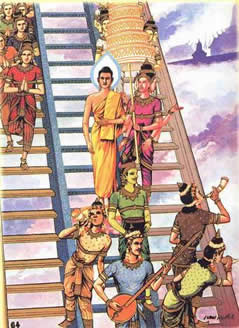
ในเมื่อต่างองค์ต่างต้องจากกันไปองค์ละทิศละทางท่านเกรงว่าอาจมีข้อ
ประพฤติปฏิบัติที่ไม่ดีไม่งามเกิดขึ้น
โดยตัวท่านเองรู้เท่าไม่ถึงการณ์หรือมองไม่เห็นเหมือนผงเข้าตาตัวเอง
แม้ผลจะอยู่ชิดติดกับลูกนัยน์ตา เราก็ไม่สนผลนั้นได้
จำเป็นต้องไหว้วานขอร้องผู้อื่นให้มาช่วยดูหรือต้องใช้กระจกส่องดู
เพราะฉะนั้น
พระท่านจึงใช้วิธีการกล่าวปวารณาตัดไว้เพื่อท่านรูปอื่นได้เห็นหรือแม้แต่
ได้ยินได้ฟัง เรื่องดีไม่ดีไม่งามอะไรก็ตาม
ให้กล่าวแนะนำตักเตือนได้โยไม่ต้องเกรงใจกันทั้งผู้ใหญ่และผู้น้อยด้วยเจตนา
ดีต่อกัน คือ พระผู้ใหญ่ก็กล่าวตักเตือนพระผู้น้อยได้
และพระผู้มีอาวุโสน้อยก็สามารถกล่าวชี้แนะถึงข้อไม่ดีของพระผู้ใหญ่ได้เช่น
กัน โดยที่พระผู้ใหญ่คือผู้มีอาวุโส
ท่านก็มิได้สำคัญตนผิดคิดว่าท่านทำอะไรแล้วถูกไปหมดทุกอย่าง การกล่าวปวารณา
เท่ากับเป็นการช่วยระมัดระวังข้อประพฤติปฏิบัติที่ไม่ดีของพระรูปหนึ่ง
ซึ่งเป็นจุดน้อยๆ นี้ที่จะลุกลามก่อความเสื่อมเสียไปถึงพระหมู่มาก
และลุกลามไปถึงพระพุทธศาสนาอันเป็นจุดศูนย์ที่ใหญ่ได้
ท่านจึงใช้วิธีป้องกันไว้ก่อน ดีกว่าการแก้ไขในภายหลัง ตัวอย่าง
วันออกพรรษาหรือวันมหาปวารณาที่พระภิกษุทั้งหลายกระทำเช่นนี้
เป็นเครื่องมือชี้ให้เห็นวิธีการคอยสังวร คือ ตามระวัง ไม่ประมาท
ไม่ยอมให้ความเลวร้ายเกิดขึ้นได้
เหมือนล้อมรั้วไว้ก่อนที่วัวจะหายไม่ว่าจะอยู่ในเทศกาลเข้าพรรษาหรือออก
พรรษา พระท่านจะประพฤติดี ปฏิบัติชอบตามระบอบของพระธรรมวินัยอยู่ตลอดเวลา
ส่วนพิธีของฆราวาสนั้นควรจะนำเอาพิธีปวารณาของพระท่านมาใช้ดูบ้าง
ซึ่งจะมีผลดีที่เกิดขึ้นแก่กลุ่มชนที่อยู่รวมกัน
ไม่ว่าครอบครัวและสังคมต่าง ๆ
มีพิธีกรรมของฆราวาสที่เกี่ยว
เนื่องกันในวันออกพรรษานี้ก็ได้แก่การบำเพ็ญบุญกุศลต่าง ๆ เช่น
การทำบุญตักบาตร รักษาศีล ฟังธรรม ณ วัดที่อยู่ใกล้เคียง
มีการทำบุญอันเป็นประเพณีที่นิยมกระทำกันมานานแล้วในวันออกพรรษา
ซึ่งเรียกว่า ตักบาตรเทโว หรือเรียกชื่อเต็มตามคำพระว่า เทโวโรหนะ
แปลว่าการหยั่งลงจากเทวโลก หรือการตักบาตรนี้เรียกอีกอย่างหนึ่งว่า
ตักบาตรดาวดึงส์ และการตักบาตรเทโวนี้ จะกระทำในวันขึ้น ๑๕ เดือน ๑๑
หรือวันแรม ๑ ค่ำเดือน ๑๑ ก็ได้สุดแท้แต่จะเห็นพร้อมกัน
การทำบุญตักบาตร
เทโวนี้ ท่านจัดเป็นกาลนาน คือ หนึ่งปีมีหนึ่งครั้ง และการกระทำบุญเช่นนี้
โดยยึดถือว่าเป็นวันคล้ายกับวันที่พระพุทธเจ้าเสด็จลงจากเทวโลก
ตามตำนานกล่าวว่า เมื่อก่อนพุทธศักดิ์ราช พระพุทธเจ้าเสด็จขึ้นไปจำพรรษา ณ
บัณฑุกัมพลศิลาอาสน์ ในสวรรค์ชั้นดาวดึงส์ เพื่อทรงเทศนา พระสัตตปรณาภิธรรม
คือพระอภิธรรม ๗ คัมภีร์ โปรดพระพุทธมารดา
(ซึ่งทรงบังเกิดอยู่ในสวรรคชั้นดุสิต) ครั้นครบกำหนดการทรงจำพรรษาครบ ๓
เดือน
พระพุทธเจ้าทรงปวารณาพระวัสสาแล้วเสด็จลงจากดาวดึงส์เทวโลกมาสู่มนุษย์โลก
ในวันขึ้น ๑๕ ค่ำเดือน ๑๑ โดย เสด็จลงทางบันไดแก้วทิพย์
ซึ่งตั้งระหว่างกลางของนับได
ทองทิพย์
อยู่เบื้องขวาบันไดเงินทิพย์อยู่เบื้องซ้ายและหัวบันไดทิพย์ที่เทวดาเนรมิต
ขึ้นทั้ง ๓ พาด บนยอดเขาพระสิเนรุราช อันเป็นที่ตั้งแห่งสวรรค์ชั้นดาวดึงส์
ส่วนเชิงบันไดตั้งอยู่บนแผ่นศิลาใหญ่ใกล้ประตู
เมืองสังกัสสนครและสถานที่นั้นประชาชนถือว่าเป็นศุภนิมิตรสร้างพระเจดีย์
ขึ้นเป็น พุทธบูชานุสาวรีย์ เรียกว่า อจลเจดีย์
การประกอบพิธีในวันออกพรรษา การประกอบพิธีในวันสำคัญนี้
เหล่าพุทธศาสนิกชนจะนิยมทำบุญกุศลเป็นกรณีพิเศษ เช่น ตักบาตรในตอนเช้า
ถวายสังฆทาน ไปทำบุญที่วัด ถวายภัตตาหาร ฟังพระธรรมเทศนา
และมีการตักบาตรเทโวในวันรุ่งขึ้น
ข้อปฏิบัติทั่วไปสำหรับพุทธศาสนิกชนในวันออกพรรษา
1.ทำบุญตักบาตรในตอนเช้า
2.ไปวัดเพื่อฟังพระธรรมเทศนา
3.ทำความสะอาดบ้านเรือน สถานที่ราชการ
มีการประดับธงชาติและธงธรรมจักร 4.ตามสถานที่ราชการสถานที่ศึกษาและที่วัด
ควรจัดให้มีนิทรรศการ การบรรยายฉายสไลต์ หรือบรรยายธรรม
เกี่ยวกับวันออกพรรษา ฯลฯ เพื่อให้ความรู้แก่ ประชาชนและผู้สนใจทั่วไป

 ประวัติการประสูติพระเยซูเจ้า
ประวัติการประสูติพระเยซูเจ้า ทำไมจึงฉลองคริสต์มาสวันที่ 25 ธันวาคม
ทำไมจึงฉลองคริสต์มาสวันที่ 25 ธันวาคม ความสำคัญของวันคริสต์มาส
ความสำคัญของวันคริสต์มาส เทียนและพวงมาลัย
เทียนและพวงมาลัย ซานตาครอส
ซานตาครอส
